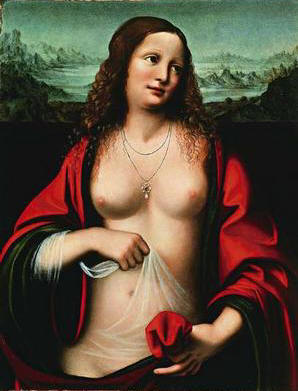
titian c1533
http://www.oceanru.com/magdalene/

“The Last Supper” by Leonardo de Vinci - showing Christ with the twelve Apostles ... John? (although some believe that this person looks like a female and could be a representation of Mary Magdalene sitting at Christ’s right hand side!) Mary Magdalene was a disciple of Jesus and has the title of Apostle to the Apostles.
http://www.holy-catholic.org/arian/liturgical_lore.html

Mary Magdalen by Da Vinci.
Life of Mary
http://www.thenazareneway.com/life_of_st_mary_magdalene.htm

Artemesia 1630-32
======
As a follower, Mary was one of many women that accompanied Jesus during his travels, most of whom are believed to have been wealthy. During his journey, he was visited by two women, the unnamed sinner in Luke 7 and Mary of Bethany, both of whom anoint his feet and dry them with their hair, similar to the way Magdalene anointed him shortly after his death..
In 591, Pope Gregory the Great stated that all three were in fact one woman, Mary Magdalene, and this is how she became labeled as a prostitute, or the unnamed sinner.
However the Second Vatican Council removed the prostitute label in 1969 after much debate and Biblical evidence that there was more than one Mary and that Mary of Magdalene and the unnamed sinner were two different figures.
"Brock, Ann Graham. Mary Magdalene, The First Apostle: The Struggle for Authority. Cambridge, MA: Harvard University Press, 2003.
Brock’s book looks at the struggle for power between Mary and Peter after Jesus’ death and immediate resurrection. She uses early Christian writings, such as the Gospels of the New Testament as well as Gnostic Gospels to show how Peter in his quest for authority subjugated the status of women that set the standard for the male hierarchy for years to come. The purpose of her book is to regain Mary’s status as the first apostle so that other Christians can look to her example, regardless of gender, and take a more active role in the church. The book is extremely well written and I recommend it to those who are examining Mary’s role in the beginning of Christianity as well as those who are trying to understand how she became better recognized as a sinner than an apostle. Ann Graham Brock is a professor at Harvard University."
http://departments.kings.edu/womens_history/marymagda.html
No comments:
Post a Comment